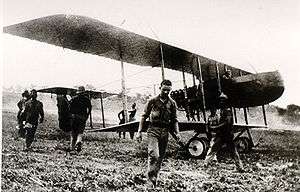Farman F.40
The Farman F.40 was a French pusher biplane reconnaissance aircraft.
| F.40 | |
|---|---|
 | |
| Portuguese Farman F.40 in Mozambique, during the East African Campaign of World War I | |
| Role | reconnaissance/observation biplane |
| Manufacturer | Farman Aviation Works |
| Designer | Henry Farman |
| Introduction | 1915 |
| Retired | 1922 |
Development
Developed from a mix of the Maurice Farman designed MF.11 and the Henry Farman designed HF.22, the F.40 (popularly dubbed the Horace Farman) had an overall smoother crew nacelle. An open tail boom truss supported a horizontal tailplane and a curved fin. The aircraft went into production in 1915.
Operational history
Forty French Air Force escadrilles (squadrons) were equipped with F.40s. They operated for just over a year, but were replaced in early 1917.
The F.40 was also operated by the No. 5 Wing of the Royal Naval Air Service, Belgian forces in France, and also by the Russians
Italian aircraft maker Savoia-Marchetti built F.40s for use by the police force until 1922.
Variants
Data from:French aircraft of the First World War[1]
- F.40
- 2-seat reconnaissance aircraft with 130 hp (97 kW) Renault 8Gc, 17.59 m (57.7 ft) span.
- F.40
- 2-seat reconnaissance aircraft with 130 hp (97 kW) DeDion-Bouton 12B, 17.59 m (57.7 ft) span.
- F.40H
- 2-seat seaplane trainer with 130 hp (97 kW) Renault 8Gc, 17.67 m (58.0 ft) span.
- F.40bis
- 2-seat reconnaissance aircraft with 160 hp (120 kW) Renault 8Gc, 17.59 m (57.7 ft) span.
- F.40ter
- 2-seat reconnaissance aircraft with 150 hp (110 kW) Lorraine 8A, 17.59 m (57.7 ft) span.
- F.40 QC
- 2-seat reconnaissance aircraft with 150 hp (110 kW) Renault 8Gc, 17.59 m (57.7 ft) span and elongated tail.
- F.40P
- adaption to fire Le Prieur rockets
- F.41
- 2-seat reconnaissance aircraft with 80 hp (60 kW) Renault 8B, 16.32 m (53.5 ft) span.
- F.41 H
- 2-seat seaplane with 80 hp (60 kW) Renault 8B, 16.32 m (53.5 ft) span.
- F.41bis
- 2-seat reconnaissance aircraft with 110 hp (82 kW) Lorraine 6AM, 16.32 m (53.5 ft) span.
- F.41bis H
- 2-seat seaplane with 110 hp (82 kW) Lorraine 6AM, 16.32 m (53.5 ft) span.
- F.1,40
- 2-seat trainer powered by an 80 hp (60 kW) Renault 8B, 17.67 m (58.0 ft) span.
- F.1,40bis
- 2-seat floatplane trainer powered by a 110 hp (82 kW) Lorraine 6AM, 17.67 m (58.0 ft) span.
- F.1,40bis
- 2-seat trainer powered by a 160 hp (120 kW) Renault 8C, 17.67 m (58.0 ft) span.
- F.1,40
- 2/3-seat trainer powered by a 130 hp (97 kW) Renault 8Gc, 17.67 m (58.0 ft) span.
- F.1,40ter
- 2-seat trainer powered by a 160 hp (120 kW) Lorraine 8Aby, 17.67 m (58.0 ft) span.
- F.1,41
- 2-seat trainer powered by a 80 hp (60 kW) Renault 8B, 16.39 m (53.8 ft) span.
- F.1,41 H
- 2-seat floatplane trainer powered by a 80 hp (60 kW) Renault 8B, 16.39 m (53.8 ft) span.
- F.1,46
- 2-seat dual-control trainer powered by a 80 hp (60 kW) Renault 8B, 17.67 m (58.0 ft) span.
- F.2,41
- 2-seat trainer powered by a 275 hp (205 kW) Lorraine 8Bd, 17.67 m (58.0 ft) span.
Army type numbers
The French Army applied type numbers to aircraft types in service. Initially these were used in a similar fashion to individual serial numbers, later used to denote similar aircraft types.
- Army Type 42
- F.40
- Army Type 43
- F.40
- Army Type 44
- F.41bis with 110 hp (82 kW) Lorraine 6AM engine.
- Army Type 51
- F.41.
- Army Type 51 E2
- F.1,41 with wings of altered camber.
- Army Type 56
- F.40bis.
- Army Type 57
- F.40ter.
- Army Type 60
- F.1,40bis.
- Army Type 61
- F.1,40ter.
Military Operators
- Belgian Air Force
- Armée de l'Air
- Royal Netherlands Air Force One aircraft only.
- Imperial Russian Air Force
- Serbian Air Force
- Soviet Air Force - Taken over for the Russian Air Force.
- American Expeditionary Force
- Venezuelan Air Force - Two aircraft only.
- Venezuelan Navy
Specifications (F.40 with Renault 8C engine)
Data from French aircraft of the First World War,[1] The Encyclopedia of World Aircraft [2]
General characteristics
- Crew: 2
- Length: 9.25 m (30 ft 4 in)
- Wingspan: 17.59 m (57 ft 9 in)
- Height: 3.9 m (12 ft 10 in)
- Wing area: 52 m2 (560 sq ft)
- Empty weight: 748 kg (1,649 lb)
- Gross weight: 1,120 kg (2,469 lb)
- Powerplant: 1 × Renault 8C V-8 air-cooled piston engine, 97 kW (130 hp)
- Propellers: 2-bladed fixed-pitch pusher propeller
Performance
- Maximum speed: 135 km/h (84 mph, 73 kn) at 2,000 m (6,600 ft)
- Range: 420 km (260 mi, 230 nmi)
- Endurance: 2 hours 20 minutes
- Service ceiling: 4,050 m (13,290 ft)
- Time to altitude: 2,000 m (6,600 ft) in 15 minutes
Armament
- Guns: 1x or 2x 7.70 mm (0.303 in) Lewis machine-gun
- Rockets: (F.40P) 10 × Le Prieur rockets
- Bombs: 240 kg (530 lb) of bombs
References
| Wikimedia Commons has media related to Farman F.40. |
- Davilla, Dr. James J.; Soltan, Arthur M. French aircraft of the First World War. Flying Machines Press. pp. 233–244. ISBN 1891268090.
- Donald, David (1997). The Encyclopedia of World Aircraft. Prospero Books. p. 399. ISBN 1-85605-375-X. Missing or empty
|title=(help)
Further reading
- Hirschauer, Louis; Dollfus, Charles, eds. (1920). L'Année Aéronautique: 1919-1920. Paris: Dunod. p. 19.
- Hirschauer, Louis; Dollfus, Charles, eds. (1921). L'Année Aéronautique: 1920-1921. Paris: Dunod. p. 27.